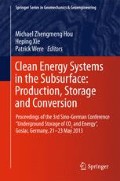Abstract
Abandoned mines are already being used for various purposes, ranging from ultimate waste disposal to energy storage and the heating and cooling of spaces. Some examples of the energy storage systems in use include hydroelectric pumping storage, wind, and compressed air. These sites represent independent and sustainable sources of energy that can be exploited to added value to local communities after the cessation of mining activity.
After abandonment, mines usually flood due to the natural rise of the water table, or they can be artificially flooded. The relatively stable temperature of this flood water could be harnessed as a geothermal resource usingheat pumps. For example, during winter, heat could be extracted from mine flood water and used for space heating, while in the summer the process could be reversed to provide space cooling.
The geothermal potential of mine flood water can be extracted via open or closed circulation systems, either through the shafts of the mine, or if still accessible, the galleries.
Although not widespread, the use of low enthalpy geothermal energy stored in abandoned mines for heating and cooling of buildings and industrial processes has already been implemented in Canada, Germany, USA and UK, with ongoing assessment projects in some communities in Europe.
The Harz region of Germany was an important mining zone fromthe Bronze Age until the 20th century, producing silver, lead, copper, and zinc. As most of the mines have been abandoned for at least 80 years, they could, in principle, be regarded as geothermal energy sources for the heating and cooling of community spaces. However, the quality of the mine water, the heat capacity and thermal conductivity of the rock, the total available length for water circulation, and the structural stability of the abandoned mines will have a significant impact on the technical feasibility of this concept.
This paper critically reviews implementation of this low enthalpy geothermal energy recovery strategy from the abandoned mines of the Harz region.
Access this chapter
Tax calculation will be finalised at checkout
Purchases are for personal use only
Preview
Unable to display preview. Download preview PDF.
References
Hartman, H.L., et al.: SME Mining Engineering Handbook. Cushing-Malloy Incorporation, Ann Abor (1996)
Hall, A., Scott, J.A., Shang, H.: Geothermal energy recovery from underground mines. Renewable and Sustainable Energy Reviews 15, 916–924 (2011)
http://www.gardguide.com/index.php/Chapter_4 (accessed April 26, 2012)
Ofner, C., Wieber, G.: Geothermische Potenziale gefluteter Bergwerke. Bundesamt für Bauwesen und Raumordnung Jahresmagazin, 72–77 (December 2008)
Cengel, Y.A., Boles, M.A.: Termodinámica. McGraw-Hill, México (2003)
Rodríguez, R., Díaz, M.: Analysis of the utilisation of mine galleries as geothermal heat exchangers by means a semi-empirical prediction method. Renewable Energy 34, 1716–1725 (2009)
Mine water Project co-financed by the European Union under the framework of INTERREG IIIB NWE programme. Mine water as a Renewable Energy Resource – An information guide based on the Minewater Project and the experiences at pilot locations in Midlothian and Heelen. PromoScence, (January 3, 2010), http://www.promoscene-database.eu/fileadmin/promoscene/downloads/Others/Minewater_Good_Practice_Guide.pdf
Kranz, K., Dillenardt, J.: Mine Water Utilisation for Geothermal Purposes in Freiberg, Germany: Determination of Hydrogeological and Thermophysical Rock Parameters. Mine Water Environ. 29, 68–76 (2010), doi:10.1007/s10230-009-0094-4
Ghoreishi Madiseh, S.A., Ghomshei, M.M., Hassani, F.P., Abbasy, F.: Sustainable heat extraction from abandoned mine tunnels: A numerical model. J. Renewable Sustainable Energy 4, 033102 (2012), doi:10.1063/1.4712055
Michel, F.A.: Utilisation of abandoned mine workings for thermal energy storage in Canada. Stockton College of New Jersey (2009), http://intraweb.stockton.edu/eyos/energy_studies/content/docs/effstock09/Session_11_1_Case%20studies_Overviews/105.pdf
European Commission, World’s first mine-water power-station opens in Heerlen. European Commission – Environment – Eco-innovation Action Plan (February 15, 2009), http://ec.europa.eu/environment/ecoap/about-eco-innovation/good-practices/netherlands/328_en.htm
Whitbread-Abrutat, P., Coppin, N.: Renewables Revive Abandoned Mines. Wardell Armstrong International (April 13, 2012), http://www.renewableenergyworld.com/rea/news/article/2012/04/renewables-revive-abandoned-mines?page=2
Watzlaf, G., Ackman, T.: Underground mine water for heating and cooling using geothermal heat pump systems. Mine Water and Environment 25, 1–14 (2006)
Banks, D., Skarphagen, H., Wiltshire, R., Jessop, C.: Mine water as a resource: space heating and cooling via use of heat pumps. Land Contamination and Reclamation 11(2), 191–198 (2003)
http://www.showcaves.com/english/de/region/Harz.html (accessed June 16, 2012)
Ließmann, W.: Historischer Bergbau im Harz. Springer, Berlin (1997)
Documents in the Bergamt of Clausthal–Zellerfeld
Author information
Authors and Affiliations
Editor information
Editors and Affiliations
Rights and permissions
Copyright information
© 2013 Springer-Verlag Berlin Heidelberg
About this paper
Cite this paper
Ramos, E.P., Falcone, G. (2013). Recovery of the Geothermal Energy Stored in Abandoned Mines. In: Hou, M., Xie, H., Were, P. (eds) Clean Energy Systems in the Subsurface: Production, Storage and Conversion. Springer Series in Geomechanics and Geoengineering. Springer, Berlin, Heidelberg. https://doi.org/10.1007/978-3-642-37849-2_12
Download citation
DOI: https://doi.org/10.1007/978-3-642-37849-2_12
Publisher Name: Springer, Berlin, Heidelberg
Print ISBN: 978-3-642-37848-5
Online ISBN: 978-3-642-37849-2
eBook Packages: EngineeringEngineering (R0)

